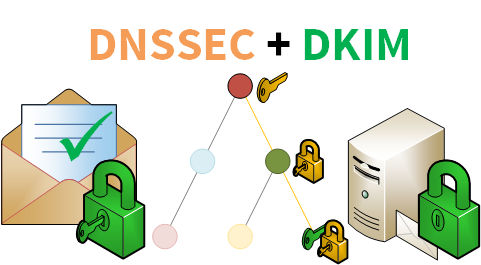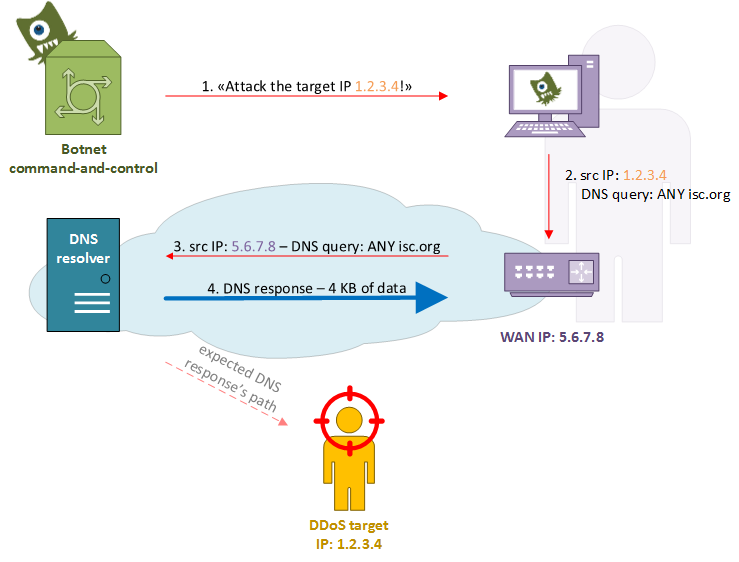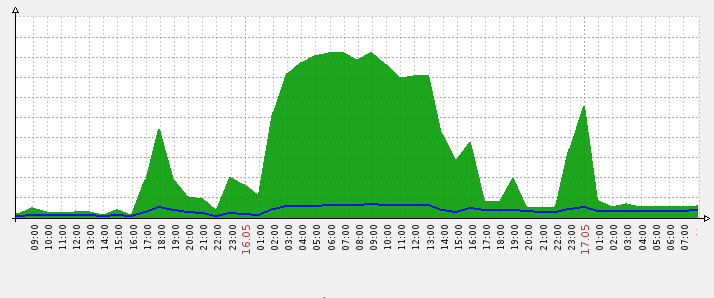I’m happy to see that more and more tools are developed to increase the security level and trustworthiness of Internet applications. I already talked about DNSSEC and tools to check the validity of domain names, many others blogged about DANE and TLSA validation support in browsers; this time I would like to focus on DKIM and on a Thunderbird add-on to verify its signatures taking advantage of DNSSEC end-to-end validation.
DNSSEC secured blog: raising awareness on DNS security
Hurray! My blog and the whole pierky.com domain are now running on a DNSSEC secured zone.
Thanks to the recent moving of the blog from the WordPress.org hosted infrastructure to the OVH hosting service I finally managed to enable IPv6 and DNSSEC support.
If you are using a DNSSEC-aware resolver (are you? check it out…) you can verify it yourself:
:~# dig +dnssec blog.pierky.com ; <<>> DiG 9.8.1-P1 <<>> +multi +dnssec blog.pierky.com ;; global options: +cmd ;; Got answer: ;; ->>HEADER<<- opcode: QUERY, status: NOERROR, id: 31643 ;; flags: qr rd ra ad; QUERY: 1, ANSWER: 2, AUTHORITY: 0, ADDITIONAL: 1 ...
There it is the ad (Authenticated answer) flag.
If your resolvers are not DNSSEC-aware – what a shame! Tell your ISP to enable them 🙂 – you can try the same using an open resolver which supports DNSSEC, like those of Google…
:~# dig +dnssec blog.pierky.com @8.8.8.8
… or you can try an online test suite, like the one provided by Verisign Labs or DNSViz.
A nice browser addon – available for Internet Explorer, Firefox and Chrome – allows you to check the DNSSEC validity of the domain names in your browser window. It’s name is DNSSEC Validator and it works even if your resolvers are not DNSSEC enabled (you can set an external resolver different from the one in use in your operating system); here it is a screenshot showing my blog’s status:
(in the above screenshot you can see a green 6 too, originated from another Chrome addon, IPvFoo, which indicates whether the current page was fetched using IPv4 or IPv6).
This is just a small drop in the ocean of Internet, but I like to believe that it might raise awareness about DNS security matter and encourage its adoption (it seems that as of September 2012 only 1.7% of the visible DNS resolvers in the Internet were performing DNSSEC validation).
References
RIPE Labs – Counting and Re-Counting DNSSEC
dnssec-deployment.org – DNSSEC in ccTLDs, Past, Present, and Future/
dnssec-deployment.org – ccTLD DNSSEC Adoption as of 2013-07-30 [PDF]
CZ.NIC – DNSSEC Validator
Verisign Labs – Test if you are benefiting from DNSSEC
Verisign Labs – DNSSEC-Debugger
Sandia.gov – DNSViz
DNS-amplification attack reflection on backhaul circuit
As many of us already know, DNS amplification attacks are a big plague for who fights every day for the sake of Internet security and service availability.
Infected hosts are instructed by botnet controllers to send DNS queries to recursive open resolvers, asking them for big zones with spoofed UDP packets containing the victim’s IP address in the source field, so that a small request would generate a big traffic toward the victim.
Small efforts are needed in order to mitigate those attacks – a proper DNS resolvers configuration to avoid open recursion, IP source validation (such as Cisco uRPF) to block source IP spoofing at the access network layer – but they may not be sufficient to immunize a network against annoying issues.
An unpleasant side effect
Even on secure networks an unpleasant side effect may occur: attack reflection against infected hosts, with the consequent backhaul circuit saturation and users’ downstream degradation.
Take, for example, the following not uncommon scenario:
An ISP, running a properly configured DNS resolver, connects many users with a shared backhaul link between its core network and a local metro area; one or more users have infected devices responding to a botnet C&C server who aims to launch a DDoS against a given target.
A well implemented network access layer would stop spoofed packets whose source IP can not be reached through the same link on which they came from. At the same time a properly configured DNS resolver would not let recursive queries to go on by untrusted sources. The problem raises when proper DNS queries came in from trusted users and go to the ISP DNS resolver.
A not-really-failed attack attempt
In the above diagram, at step 1, the botnet controller instructs the infected host to start a DNS amplification attack against the victim’s IP address 1.2.3.4. In the step 2 the malicious software tries to send a spoofed packet containing the victim’s address in the source field but something goes wrong: the operating system doesn’t let the malware to forge such a packet and rewrites it using its LAN address, or the router/firewall/CPE changes it with the WAN IP address (NAT). Anyway, at step 3, a proper DNS query comes out the user’s network and heads to the ISP DNS resolver, which in turn sends back a response with the huge DNS zone (step 4).
It’s easy to understand how this behaviour could lead to ISP internal issues regarding the backhaul link saturation and the users experience’s deterioration.
Consequences
A small upstream user’s query (65 bytes for an ANY query on isc.org) produces a big downstream response (~ 4 KB for isc.org zone), with a ~ 60x multiplicative factor. Every infected host may send many and many queries over a long period, even more than 1 query per second for many days, and many compromised hosts may be triggered at the same time by the same botnet controller.
Backhaul links may be rent from incumbent local carriers and may be characterized by an overbooking ratio calculated over the expected usage by customers who share them; high speed links which connect DNS resolvers to the core may overwhelm them when filled by UDP response packets and lead to traffic stagnation because of traffic policing operated by the carrier.
Customers also may report a bad user experience: it’s true, their links are operating at 100% of their capacity, but Facebook is slow and the VoIP is unusable.
A very big headache, even for an ISP with a properly configured network.
Symptoms
The first symptom that can be observed is an abnormal peak in resolvers bandwidth usage:
During an attack attempt the network usage (servers’ upstream) may raise up to hundreds of times higher than average.
NetFlow also may help us to identify this kind of traffic; big response UDP datagrams may be fragmented over the network and they would be shown as port-0 UDP packets in the output of nfdump or similar tools, with an high Bpp (bytes-per-packet) ratio:
Proto Src IP Addr:Port Dst IP Addr:Port Packets Bytes pps bps Bpp Flows UDP RESOLVER_1:0 -> A.B.1.155:0 78966 106.6 M 48 519300 1350 79 UDP RESOLVER_1:0 -> G.H.4.73:0 35798 48.3 M 25 274100 1350 38 UDP RESOLVER_1:53 -> I.J.5.101:14068 7430 9.3 M 4 46712 1249 187
Mitigation
Unfortunately, as far as I know, there are still no specific implementations aimed to mitigate those kind of attack.
BIND9 has a generic rate-limit option which prevents a requestor to be told the same answer more than a specific number of times within a one-second interval, but there is no way to apply it only to a subset of responses (like the ones used in DDoS attack, such as ANY to isc.org or ripe.net). DNS RRL (Response Rate Limiting) is focused on authoritative servers, not on recursive ones.
A suitable way would be the use of the iptables recent module on recursive resolvers, but other aspects have to be considered, such as servers load and performances degradation.
A first deep-packet inspection of the incoming DNS requests would filter those DNS queries whose type has been set to ANY, then the recent module would lookup the source IP address on a local list and drop the packet if it violates the predetermined policy. For example, a policy may allow one or two queries with type = ANY every 5 seconds, so that “regular” usage would be allowed while malware initiated traffic would be dropped within few seconds.
References
“Alert (TA13-088A) DNS Amplification Attacks”, US-Cert: http://www.us-cert.gov/ncas/alerts/TA13-088A
“DNS Response Rate Limiting (DNS RRL)”, Paul Vixie, ISC – Vernon Schryver, Rhyolite: http://ss.vix.su/~vixie/isc-tn-2012-1.txt
NetFlow: installation and configuration of NFDUMP and NfSen on Debian
After the brief overview about the installation of flow-tools and FlowViewer, in this post I’d like to share my experience about the setup of a basic solution based on another pair of tools: NFDUMP and NfSen. As always on my posts, the starting point is a fresh Debian 5.0 setup.
UPDATE: you may be interested in FlowGraph too, a tool that allows to dynamically build graphs based on previously collected netflow data and to use them in a web-based front-end, adding details about Autonomous System Number holders, IPv4 and IPv6 prefixes, inet(6)num objects, netnames from RIPE Stat.
NetFlow: weird TCP flags in FlowViewer and flow-print?
Working with FlowViewer and flow-print (from the flow-tools suite), if you filter some NetFlow data by TCP flags you may notice a weird behaviour, like the one in the following picture:
Here I applied a filter on TCP Flags = 27, but on the output I had the “Fl” (Flag) column reporting 3! What’s up? Is 3 a kind of alias for 27? Is this a math puzzle? None of this!







